A Deep Dive into Future of Banking: How Will Refinance Costs Evolve?: A Beginner’s Guide

The Future of Banking: A Deep Dive into How Refinance Costs May Evolve
In an ever-evolving world, one industry that has consistently adapted and transformed itself is banking. With advancements in technology and changing consumer expectations, the future of banking is set to shake up traditional practices. In this beginner’s guide, we will explore how refinance costs may evolve in the years to come.
Understanding Refinance Costs
Before diving into the future, let’s first understand what refinance costs entail. Refinancing refers to the process of replacing an existing loan with a new one, typically to secure a better interest rate or loan terms. However, refinancing comes with certain costs that borrowers need to consider.
Refinance costs can include various fees, such as application fees, origination fees, appraisal fees, closing costs, and more. These costs can add up, and borrowers need to evaluate whether the potential savings from refinancing outweigh the expenses.
The Evolving Landscape of Refinance Costs
As technology continues to reshape the banking industry, the landscape of refinance costs is poised for change. Here are a few key factors that may impact refinance costs in the future:
1. Automation and Streamlined Processes
With the rise of automation, banks and financial institutions are streamlining their processes, reducing manual work, and increasing efficiency. This could lead to lower operational costs, which may translate into reduced refinance costs for borrowers.
2. Enhanced Competition
The future of banking will likely witness increased competition as new players, including fintech startups, enter the market. This competition may drive down refinance costs as different institutions vie for customers, offering better terms and lower fees to attract borrowers.
3. Transparency and Fee Reduction
In response to consumer demand and regulatory requirements, banks are becoming more transparent about their fees and charges. This transparency may result in a reduction of hidden or unnecessary fees related to refinancing, making it more cost-effective for borrowers.
Frequently Asked Questions (FAQs)
Q1: Is it worth refinancing if the costs are high?
A1: While high refinance costs may seem daunting, it’s essential to weigh them against potential long-term savings. Calculate the break-even point – the time it will take for the new terms to offset the costs. If you plan to stay in your home beyond that break-even point, refinancing may be worth considering.
Q2: How can I reduce refinance costs?
A2: To reduce refinance costs, it’s crucial to shop around and compare offers from different lenders. Negotiate a waiver or reduction in certain fees. Also, consider refinancing with your current lender, as they might offer incentives or reduced closing costs for existing customers.
Q3: Will my credit score impact refinance costs in the future?
A3: Your credit score plays a significant role in determining your refinancing costs. A higher credit score typically translates into better loan terms and lower interest rates. As the future of banking unfolds, maintaining a good credit score will remain essential to secure favorable refinancing options.
Conclusion
The future of banking holds immense potential for reshaping the landscape of refinance costs. As technology advances, competition increases, and transparency improves, borrowers may benefit from reduced costs and better terms. Stay informed, explore your options, and make financially wise decisions to navigate the changing world of banking and refinancing.
Disclaimer: The information provided in this article is for general informational purposes only and should not be considered financial or professional advice. Consult with a qualified financial advisor or bank representative before making any financial decisions.



